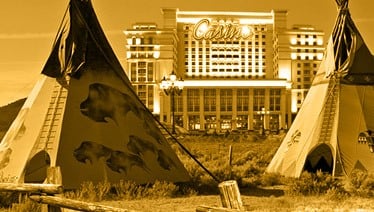In 1987 the Supreme Court ruled that states that offered legalized gambling could not regulate gambling on Native American lands. Since that time numerous tribal governments have opened casinos. They look to casino gambling as a way to generate jobs in the often-remote areas and bring in needed funds.
Surveys of these casinos show that, by and large, the casinos haven't produced the desired results. The rate of tribal members who receive welfare hasn't decreased, unemployment rates remain high and significant numbers of reservation residents still live on land with no water or sewer intrastructure.
One elderly resident commented about $40 million hotel, golf and gambling resort that was built on her tribal lands "We get no help from the casino, no money, nothing."
Casinos on Tribal Lands
The story is similar in reservations throughout the United States. Indian gambling revenues have increased dramatically over the past few decades. Yet, according to a computer analysis of federal poverty, unemployment and public assistance records, the proceeds haven't trickled down to benefit the majority of individual American Indians who live on the lands that host the casinos.
Two-thirds of the American Indian population is locked in poverty. Either their tribal lands don't host casinos or the casinos on their lands don't impact on the quality of life of the average resident of these lands.
There are 130 tribes with casinos. Those located near major population centers are thriving. The others make just enough to cover the bills. The casinos do generate some jobs but not enough -- unemployment on reservations with established casinos is still over 50%. The jobs don't always go to the reservation's Indian residents either. Louise Benson, chairman of the Hualapai Tribe, whose casino failed, said "Everybody thinks that tribes are getting rich from gaming and very few of them are.”
There are approximately 500,000 Indians whose tribes operate casinos. Of those, only about 80,000 belong to tribes with casinos that generate more than $100 million a year.
History
A dispute between the Cabazon Band of Mission Indians and the State of California over gambling on tribal lands reached the Supreme Court in 1987. The Court ruled that the authority to regulate gaming activities on tribal lands falls outside those powers granted by the Public Law 280. This means that states where gambling is legal cannot regulate native American gambling activities. Gambling on tribal lands in states that offer legalized gambling can only be regulated on a Federal level by Congress, the court ruled.
Successful Casinos
The Shakopee Mdewakanton Dakota Tribe in Minnesota is one of 23 tribes which operate successful casinos. They pay each member hundreds of thousands of dollars a year. Scott County Minnesota, where a large number of tribal members live, saw a poverty rate decrease of 4.1 percent 3.5 percent over the course of six years. The reservation’s unemployment rate plummeted from 70 percent to just 4 percent, 7 years later.
Casinos that see big profits include the Mashantucket Pequot tribal Casino of Connecticut whose casino is located about halfway between Boston and New York and the Seminole Tribe’s Hollywood Gaming Center which is located on Miami’s Gold Coast. These casinos generate hundreds of millions of dollars every year and help keep the unemployment rates on those reservations in the single digits.
Poverty Rate
In many of the tribes where some form or another of gambling is operating, the gambling revenues pay for little more than for debt service and the casino operations themselves. Little is left over to put towards upgrading the quality of life for the reservation's residents.
Statistics show that the poverty rate is declining only slightly in counties that contain reservations with casinos. Counties with reservations with no gambling seem to be able to maintain a relatively steady poverty rate.
Jonathan Taylor is a research fellow at the Harvard University Project on American Indian Economic Development. He points out that many investments that gaming tribes make in social and economic infrastructure don’t translate into immediate improvements in poverty and other quality-of-life indicators. “You see investments arising out of gaming taking hold slowly in greater educational success, greater family integrity, greater personal health, greater crime prevention.”
Hopeful Signs
Despite the troubling statistics some tribes hope that, once the casino construction loans are repaid, they''ll be able to turn more of their profits towards the benefits of their residents. One hopeful sign comes from an analysis of county business patterns which shows that economic development is being spurred in communities near tribal casinos. Thanks to the Oneida Casino in central New York State the Oneida Indian Nation has become the largest employer in Madison and Oneida counties.
Unemployment
Unemployment for Indians remains high, even in areas that have casinos. Tribes with established casinos are seeing their unemployment rates climbing. The former executive director of the National Indian Gaming Association, Jacob Coin, explained that 75 percent of jobs in tribal casinos are held by non-Indians.
Along the California-Arizona-Nevada border, Gary Goforth, tribal administrator at the Fort Mojave Indian Reservation acknowledged that only a few of the 675 jobs at the tribe’s two casinos are filled by tribal members. “Not everybody wants to be a dealer, or a housekeeper or even a manager in the restaurant.”
San Carlos Apache Tribal Chairman Raymond Stanley, whose tribe runs the relatively successful Apache Gold Casino, said, even in his tribe's casino, where 80% of the workers are tribal members, the profits that the casino generates don't meet the needs of the reservation's population. “We really don’t have a lot to show for it at the moment,” he said. “The real benefit right now is employment."

